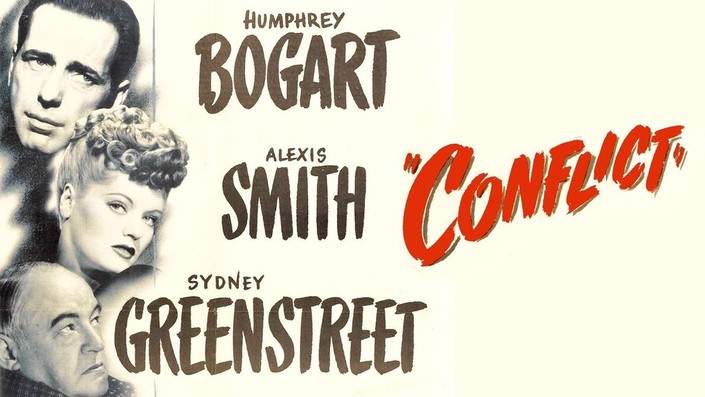Conflict (1945)

DIRECTOR: Curtis Bernhardt
CAST: Humphrey Bogart, Sydney Greenstreet, Alexis Smith, Rose Hobart, Charles Drake, Pat O’Moore
REVIEW:
Filmed in 1943 but not released until 18 months later, directed by Curtis Bernhardt and scripted by Arthur T. Gorman and Dwight Taylor based on the short story The Pentacle by Robert Siodmak and Alfred Neumann, Conflict is a moderately diverting but routine example of one of those atmospheric black-and-white suspense noirs of the 1940s and 1950s (far from the only one to star Humphrey Bogart) that does a watchable job of keeping us intrigued with twists and turns in the moment, even if the big reveals don’t make a lot of sense in the end. It has its moments, but its series of contrivances leave it one of Bogart’s lesser films from the time period.
The movie doesn’t waste much time on set-up. Wealthy engineer Richard Mason (Humphrey Bogart) and his wife Kathryn (Rose Hobart) appear from the outside to have a happy marriage, but the inside is less rosy. Richard is in love with his wife’s younger sister Evelyn (Alexis Smith), a fact his wife confronts him with and which he does not deny, although he appears resigned to its impossibility and she vows that she would never grant him a divorce. A short time later, after an anniversary party thrown by their friend, psychologist Dr. Mark Hamilton (Sydney Greenstreet), the unhappy couple gets in a car accident which leaves Richard with a broken leg. And during his time bedridden, a thought starts percolating in his head. It’s not long before Richard cunningly devises a plot to murder his wife—-pretending to be wheelchair-bound long after his injury has healed and ambushing his wife along a lonely mountain road after arranging an alibi to appear to still be at home—-but just as he thinks he’s finally free to pursue Evelyn, strange things start happening. A pickpocket turns up with Kathryn’s ring and claims to have stolen it from a woman matching her description. Richard smells her perfume in their bedroom, and her wedding ring somehow finds its way back into their safe. As seemingly impossible incidents mount, the increasingly paranoid Richard must ponder—-along with the audience—-whether he’s losing his mind, whether Kathryn is somehow still alive, or whether something else is afoot.
Conflict is a prime example of a “refrigerator movie” that serves up enough twists and turns to keep us watching until the end and serves up a “big reveal” that neatly ties up everything but makes less sense the more you reflect on it. Director Curtis Bernhardt hearkens back to German expressionism (Bernhardt was a German expatriate) with the film’s look dominated by long shadows and dark rooms, giving it an atmospheric Gothic air. There’s also too much psychological monologuing delivered by Greenstreet’s Dr. Hamilton, typical of 1940s fascination with psychology which was often woven into crime films.
Humphrey Bogart was apparently reluctant to play a more “villainous” role as a wife-killer, although he would play one again two years later in 1947’s The Two Mrs. Carrolls, where his character would once again kill for the love of Alexis Smith. Sydney Greenstreet’s character feels so superfluous despite getting an inordinate amount of screentime that you just know he’s going to be relevant to how the plot unravels, contributing to the predictability. Incidentally, this was one of five times that Greenstreet co-starred with Bogart, although it’s not up to the level of some of their other collaborations like Casablanca or The Maltese Falcon. Meanwhile, Alexis Smith’s doe-eyed Evelyn is little more than a motivation/red herring.
Conflict’s central questions—-Is Richard losing his mind and haunted by a guilty conscience? Is Kathryn somehow still alive? Is Hamilton/Evelyn/the police or some combination of the above playing an elaborate game to entrap him?—-keep us guessing enough to stick out the brisk 86 minute runtime and see how it ends, but the artificiality and contrivances in the way characters and law enforcement behave keep it from being more than a mostly forgettable diversion that never ascends to top-tier film noir.
* * 1/2